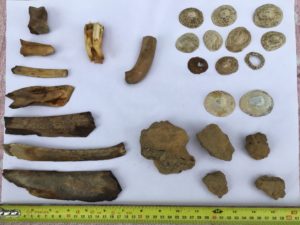
Aug
Cob Wall Reveals Hidden History
Inside a traditionally built cob wall in Cornwall you’d expect to find the standard ingredients – small stones, clay and straw. These materials have been the staple of cob in construction since we left the caves. They each have a key role in the mixing, drying and consolidation processes of building with earth and are crucial to constructing a strong wall.
All of these items were unearthed whilst undertaking cob repairs in Cornwall to this cob wall.
Situated on the 1st floor of a former barn of 17C origin, latterly an inn during the early 1800’s – 1900’s and now a dwelling, this cob wall has provided conclusive evidence that clay content is limited. Even without intrusive analysis this cob wall ‘looks’ the wrong colour… ie it doesn’t display the usual ochre hues one expects to see. In addition, it is incredibly ‘crumbly’….consistent with a lack of clay as a binder.
Introducing cob repairs;
Unavoidable aspects of [most] cob repairs in Cornwall is the inevitable removal of some of the existing fabric/s. In this instance, careful ‘chasing-out’ was required to enable the introduction of pre-formed cob bricks and cob blocks. We retrieved and bagged ALL of the spoil, took it back to the workshop and began ‘sorting’.
Most noticeable was the limpet shells.

Conclusion [?]
Having established that the cob wall in Cornwall is lacking in clay content and in conjunction with the ‘finds’ within the cob itself – have we stumbled across (part of) an ancient settlements’ cooking site? Medieval, Saxon or earlier? Did the cob ‘builders’ of this wall not know about the [lack of] clay? Was this material the only material to hand?
They would certainly have known about the presence shells and bones but did they realise (or even care) its age?
The limpets were undoubtedly a food source and these shells still retain their exterior coarseness unlike beach-washed shells which are smooth










